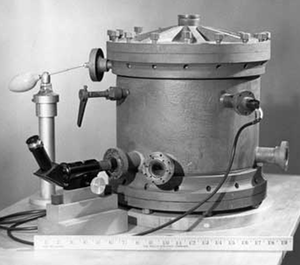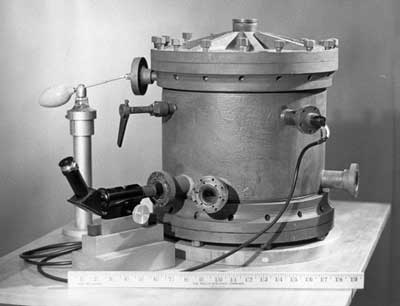Landmarks—Millikan Measures the Electron’s Charge
Landmarks articles feature important papers from the archives of the Physical Review journals.
Researchers now routinely isolate single electrons in quantum dots, but a century ago the state-of-the-art charge-trapping device was a droplet of clock oil. Robert Millikan’s oil drop experiment provided the first clear measurement of the fundamental electric charge and thus helped cement the notion that nature is “grainy” at the smallest level. The first results came out in 1910, but the seminal work was a 1913 paper in the Physical Review. Millikan reported a value for the fundamental electric charge that was within half a percent of today’s accepted value. The experiment helped earn Millikan a Nobel prize in 1923 but has been a source of some controversy over the years.
J. J. Thomson discovered the electron in 1897 when he measured the charge-to-mass ratio for electrons in a beam. But the value of the charge and whether it was fundamental remained open questions. Thomson and others tried to measure an irreducible electric charge by looking at clouds of water droplets. Using various techniques, they estimated the smallest charge that a droplet could hold, but the results were not entirely convincing because they relied on averages over many particles of various sizes. “The evidence for a unitary charge was at the time very ambiguous,” says science historian Gerald Holton of Harvard University.
At the University of Chicago in the 1900s, Millikan and his graduate students realized that ramping up the electric field would disperse a water cloud, so that only a few droplets remained. He decided to try isolating single droplets, but it soon became clear that single water droplets evaporated too quickly to make reliable measurements. One of his students, Harvey Fletcher, found that long-lasting droplets could be made with a light oil that was used for lubricating clocks.
The oil drop experiment that Millikan and Fletcher designed had two chambers. In the upper chamber, an atomizer (like that used in perfume bottles) dispersed a fine mist of micron-sized oil droplets. Individual droplets would fall through a pinhole into the lower chamber, which consisted of two horizontal plates, with one held 16 millimeters above the other. The air in this chamber was ionized with x rays, so that ions or free electrons could be captured on the falling droplets. A small window on the side allowed the scientists to observe the droplets through a telescope. The droplets fell slowly enough—due to atmospheric drag—that the researchers could measure their downward speed by eye, using horizontal lines in the telescope. From this speed, they could estimate the size and mass of each droplet.
They then applied a high voltage across the plates and measured the upward speed of the droplet, to determine the electric force and ultimately the charge. Multiple measurements on a single droplet could be performed by repeatedly turning the electric field on and off. The droplets had various amounts of charge on them (and they would often gain or lose charge during an observation), but the data showed that the charge was indeed quantized into integer multiples of a unit charge.
In 1910 Millikan published the first results of these experiments [1] (Fletcher was not included as an author, based on a deal the two struck [2]). Millikan then made several improvements, including an empirical estimate of the drag forces. The culmination of this effort, reported in 1913, was a value of the fundamental charge with an error bar of just 0.2 percent. The precision acquired was so great that “other experiments did not improve on his result until a decade later,” Holton says.
But Felix Ehrenhaft of the University of Vienna repeatedly challenged Millikan’s results, based on his own measurements of “sub-electron” charges on small metal particles. The dispute lasted for many years—known as the “Battle over the Electron”—but eventually most physicists sided with Millikan.
In more recent years, historians who have examined Millikan’s lab notes have said that he discarded some of the measurements to boost the evidence of a fundamental charge. But David Goodstein of the California Institute of Technology in Pasadena believes these accusations of fraud are unwarranted. He has analyzed the notes and says that Millikan excluded droplets because their observations were incomplete, not because their implied charge didn’t match his expectations [3]. “Millikan’s oil drop experiment is a classic example of outstanding physics done by one of the giants of his era,” Goodstein says.
–Michael Schirber
Michael Schirber is a Corresponding Editor for Physics Magazine based in Lyon, France.
References
- R. A. Millikan, “The Isolation of an Ion, a Precision Measurement of its Charge, and the Correction of Stokes’s Law,” Science 32, 436 (1910); first reported at the American Physical Society meeting, 23 April 1910, Phys. Rev. (Series I) 30, 656 (1910)
- H. Fletcher, “My work with Millikan on the oil‐drop experiment,” Phys. Today 35, 43 (1982)
- D. Goodstein, “In Defense of Robert Andrews Millikan,” Am. Sci. 89, 54 (2001)





